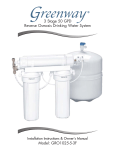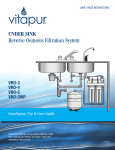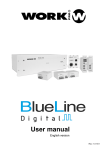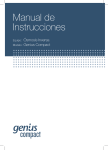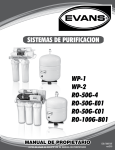Download Global Water Water Box Use and Care Manual
Transcript
WATER BOX OPERATION MANUAL 1|Page Table of Contents Introduction…….……………………………………………………………………………………..pg.3 Setting up the Water Box.……………………………………………………………………….pg.3 How The Water Box Works…….……………………………………………………………...pg.4 Water Connections………………….…………………………………………………………..…pg.5 Feed Water Connections………………………………………………………………….……p.g.6 Drain Connections………..……………………………………………………………………….p.g.7 Installing the Faucet…….……………….……………………………………………………..pg.8,9 Battery Installation……………………….…………………………………………………........pg.9 EZ Connections…………………………….……………………………………………………….pg.10 System Start Up………………………….…………………………………………………………pg.11 Filter Replacement…………………….………………………………………………………….pg.12 Reverse Osmosis Membrane Replacement.…………………………………….……pg.13 Troubleshooting……………………………………….………………………………………....pg.14 Specifications………………………………………….………………………………………..….pg.14 Warranty……………………………………………………….……………………………………..pg.15 List of Figures Figure 1 Water Connections…………….. ………………...….…………………………….pg.5 Figure 2. Feed Water Connection………………….….………..………………………….pg.6 Figure 3. Drain Connection..………………….……….….……………..……………………pg.7 Figure 4. Faucet Installation…………..………………...…………………………………...pg.8 Figure 5. Reverse Osmosis Membrane Replacement…………………….……...pg.13 2|Page Introduction Congratulations on your purchase of our revolutionary purification system, the Water Box! Our Reverse Osmosis system is designed to replace the conventional 5 gallon water bottle while eliminating the hassles of deliveries, lifting bottles and eliminating plastic bottles from landfills. The Water Box is connected to your city or well water supply to efficiently filter out tastes and odor, and to remove microscopic contaminants by using reverse osmosis purification technology. The Water Box only dispenses room temperature water. The “RO” system utilizes a CSM Reverse Osmosis water purification filter which produces pure safe water from city or well water. The “RO” assembly is comprised of 4 filters. The first stage is a 5-micron sediment filter, a carbon (GAC) 10-micron filter, CSM RO membrane and a post carbon filter to improve taste. The “RO” filter assembly requires a drain line connection to be installed which removes rejected water to the sewer. Please read all the instructions in this manual before operating this unit. Setting Up the Water Box Connections that need to be made: 1. Setup your Feed water connection 2. Setup your Drain connection 3. Setup your faucet connection After your connections are made you need to: 1. Install the batteries 2. Flush the filters 3|Page How the Water Box works The Water Box Reverse Osmosis (RO) System uses a semipermeable membrane to reduce dissolved salts and minerals, improving the taste and odor of your water. The RO membrane is made of layers of micronthin film wound around a hollow center core. Water molecules can pass through the membrane, but dissolved salts and minerals are rejected. The Water Box Reverse Osmosis System features 4-stage filter action. Your water supply is pre-filtered to reduce dirt and chlorine that may foul the membrane. The RO membrane separates this pre-filtered water into PRODUCT WATER and DRAIN or REJECT WATER. Incoming water pressure forces the product water through the membrane and into the storage tank. Dissolved solids and other contaminants cannot pass through the membrane and are sent to the drain as reject water. When you open the drinking water faucet, product water is drawn from the storage tank through an activated carbon post-filter, providing you with cleaner, great-tasting water. For each gallon of water produced, several gallons are discharged as reject water. The storage tank can hold up to 1 gallon of water at a time, for drinking and cooking needs. Blue LED Light The Blue LED light is used as a filter replacement indication light. The batteries last about 6 months. This is about the same time filters need to be replaced. 4|Page Water Box Connections When you receive the water cooler, the water connections on the back have tube plugs in them. These tube sections must be removed before making all your connections. To remove the tube sections see Page 9 “Disconnect”. The 1/4" plastic tubing should be used for making the Feed Water, Drain connections and Faucet connections. Note: If hard copper tubing is used for the Feed Water and Drain connections the bulkhead fittings must be changed to a metal fitting. Figure 1. Water Connections 5|Page Feed Water Connections Figure 2. Feed Water Connection 6|Page Drain Connection (Applies to models with Reverse Osmosis “RO” only) The drain line in the back (Fig. 4) must be hooked to the drain line ahead of the normal sink water trap. See Figure 3 below. Place the 2 part drain saddle on the drain pipe before the drain trap. Allow proper space for the drilling operation. Tighten the saddle bolts evenly on both sides. Using the opening in the drain outlet saddle as a guide, drill a 1/4” hole in the drain pipe. Clean any debris out of the drain saddle connection. Connect the drain line to the cooler using the 1/4” black tubing supplied. Figure 3. Drain Connection 7|Page Installing the Faucet 1. Faucet base 2. Small washer and chrome plate 3. Large washer 4. Kitchen sink 5. Bottom plate 6. Lock Washer 7. Lock Nut 8. Tube Insert 9. Sleeve 10. Faucet Nut Figure 4. Faucet Installation Drill 5/8” hole on sink The Faucet should be positioned with aesthetics, function and convenience in mind. An ample flat service is required for the faucet base so that it can be drawn down tight. Also check the under sink area of the desired location to see if there is ample space to complete the faucet installation. If the space is not available on the upper sink area, the faucet could be positioned on the counter top at the edge of the sink. Be sure to watch for obstructions below, i.e., drawers, cabinet walls, support braces etc. If the counter top is ceramic tile, the method for drilling the hole should be the same as for a porcelain sink. Note: The sink drilling process, although not complicated, requires a 8|Page certain amount of caution and forethought. Porcelain sinks can chip if care is not exercised. PORCELAIN ENAMEL SINK/ STAINLESS STEEL SINK/ ALUMIUM SINK A 5/8” hole is required for the faucet. It is recommended that you get special drill bit for porcelain and tile counter. 1. Place a piece of masking tape or duct tape on the determined location where the hole is to be drilled. 2. Use a variable speed drill at slow speed with 1/8” drill bit, and drill a centering hole in the center of the desired faucet location. 3. Enlarge the hole using a 1/ 4” drill bit. 4. Enlarge the hole using 7/16”, 1/ 2”, and 5/8” drill bit. Pause occasionally to cool the drill bit. 5. File or clean the surrounding area and remove the masking or duct tape. (NOTE: the metal chips on porcelain will stain very fast) 6. DON’T put Teflon tape at the tip of the threaded mounting base of the faucet since it’s a compression fitting. 7. Put the small rubber washer, the chrome base plate, large rubber washer according to the diagram through the threaded mounting tube at the base of the faucet. 8. From under the sink, install the bottom plate, lock washer, and nut. Then screw on tightly. 9. According to the diagram, put the brass nut through the BLUE tubing first, then plastic sleeve (preferred), or brass sleeve, then the plastic insert. Push the white plastic sleeve against the insert. 10. Screw on the Blue tubing with brass nut to the faucet base. Uses wrench to tighten the nut but don’t over tighten it. Too tight would cause leak. 11. The spout can swivel 360-degrees. The faucet lever can be pushed down for dispensing or pulled up for continuing dispensing Battery Installation To install the batteries simply unscrew the top cover of the water box. The 2 screws are located in the back of the Water Box on the top cover. Install the batteries and LED light will illuminate. 9|Page EZ Connections The standard tubing connections on the water coolers are EZ connect fittings. Use the tubing provided and follow the instructions below to make the connections. If you cut the tubing, make sure it is a square cut, fits squarely in the fitting and seals properly. Cut the tube square “O” Ring Collet Stainless Steel Teeth Cut the tube square. It is essential that the outside diameter is free of score marks and that burrs and sharp edges be removed before inserting into fitting. For soft thin walled plastic tubing we recommend the use of a tube insert. Insert tube Fitting grips before it seals. Ensure tube is pushed into the tube stop. Push up to tube stop Push the tube into the fitting, to the tube stop. The collet (gripper) has stain-less steel teeth which hold the tube firmly in position while the “O” ring pro-vides a permanent leak proof seal Pull to check secure Pull on the tube to check it is secure. It is good practice to test the system prior to leaving site and/or before use. Push in collet and remove tube Push Collect in Disconnect 10 | P a g e Pull Tube Out To disconnect ensure the system is depressurized before removing fitting. Push in collet squarely against face of fitting. With the collect held in this position, the tube can be removed. System Start-up Once all your connections are complete you are ready to prime or flush the filters. To do this simply turn on the water and open the faucet. You will notice water coming out of the drain line. This is normal and will stop when the Water Box is completely filled with water. Let the system flush through the faucet for about an hour. In that time you will notice fine black carbon particles. These particles are harmless, but may make the water appear grey in color. Note: The reverse osmosis membrane is treated with a food grade sanitizing agent that may cause an undesirable taste. Although it is not harmful, it should be flushed from the system. NOTE: The RO system does not produce a high volume of water on demand as an ordinary filter does. Water is produced at a slow, drop-bydrop rate. The system requires about 30 minutes to fill the storage tank. As water is taken from the tank, the system automatically starts the cycle of replacing the water and then stops water production when the tank is full. CAUTION: Visually check the entire system for leaks. If a leak is present, make sure all of your connections are pushed in tightly. NOTE: Initially, the water may appear cloudy. This is a result of air trapped in the post-polishing filter. It is not harmful and will disappear in a matter of minutes. It may take up to a week after installing a new post-polishing filter for the trapped air to dissipate. 11 | P a g e Water Box Filter Replacement The filter elements must be replaced at regular intervals to maintain the quality of the water. The Water Box has 4 stages of Reverse Osmosis filtration. The first stage is the 5-micron sediment filter. The second stage is the activated carbon filter. The third stage is the post carbon filter. These filter elements must be replaced every six months. The Reverse Osmosis filter; the larger of the 3 must be replaced every 3 years. Replacement Procedures, Filtration Versions a) Turn your water supply off going to the Water Box. b) Unscrew the 3 covers with a Phillips head screwdriver. c) Turn the blue valve on the holding tank to the off position. d)Place a towel under the filters to catch water. The filters will have water in them which will run out when the filters are unlocked. e) Twist the filters to remove them from their housings. f) These filters are disposable, encapsulated filters. Remove and discard the entire filter body. Replacement filters are sold as a set: 1st Stage sediment filter 2nd Stage carbon filter 3rd Stage post carbon P/N ETSET f) Twist new filters on the housing brackets. g) Turn the blue valve on the tank back to the on position. h) Open the water supply and let water flow through filters. Leave the faucet on and let the water activate the filters for 1 hour. i) Let the Water Box fill up ensuring you don’t have any leaks then re-install the panels. 12 | P a g e Reverse Osmosis Membrane Replacement (RO) (every three years) a) Use the same procedure as above sec a-c. b) Remove the RO stage from the clips. Disconnect the white tubing from the RO housing cap. c) Remove the cap from the housing by unscrewing it. d) Using a pair of pliers, remove the RO element from the housing by grasping the tube end and pulling it out. e) Use RO filter replacement P/N CSM50 (50gpd CSM membrane). Insert the element into the housing with double “o”-ring end going in first–toward the bottom of the housing. Make sure the “o”-rings are sealed. Replace the cap. Reconnect the white tubing. Proceed as in above section (g) to (i) Figure 5. Reverse Osmosis Replacement 13 | P a g e PROBLEM LED Light is not illuminated CAUSE Batteries not installed or need to be replaced. Leaks at connections Depress plastic collar and pull tube out. Cut off 1 inch of tube. (Make sure you cut squarely). Reinsert tubing, turn water on and check for leaks. Filters need to be Once all connections primed (flushed). have been made. Open the faucet and let the water run through it Water Tastes Bad SOLUTION Install the 2 batteries by removing the top cover. Open the water box and make sure each and every tube is pushed in. Trouble Shooting Guide 14 | P a g e for 1 hour. Note - In the event of problems beyond the scope of the troubleshooting described in the manual, please call your selling dealer. Specifications Model No. Water Box High Side Pressure 125 psi Low Side Pressure 15 psi Ambient Tank Capacity 2.3 Gallons Warranty All Global Water products are warranted to be free from defects in materials and workmanship under normal use within the condition of operation listed for a period of 1 year from date of purchase. There is no liability assumed by the company for damage due to water leakage or other secondary effects from any component defect. Labor is not covered in this warranty. The warranty applies when “Conditions of Operation” below are met. Conditions of Warranty Water System Pressure 35 -100psi, Temperature, 40 -100degrees F, Water PH range 4-10, Max. TDS 1500 PPM, Turbidity, <1.0 NTU, 15 | P a g e Water Hardness < 20gpg, Iron <0.1 mg/l, Manganese <0.1 mg/l, Hydrogen Sulfide < 0.00 mg/l *For filter only systems (“F” models), water hardness must be less than 3.5 grains or 60 mg/liter 16 | P a g e Cleaner, Healthier Water. 3937 Pembroke road, Hollywood, Florida 33021 www.Bluline.com Tel. (786) 235-2518 Fax (786) 207-2570 Email [email protected] 17 | P a g e






















